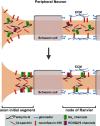Ankyrin protein networks in membrane formation and stabilization
- PMID: 19840192
- PMCID: PMC4515052
- DOI: 10.1111/j.1582-4934.2009.00943.x
Ankyrin protein networks in membrane formation and stabilization
Abstract
In eukaryotic cells, ankyrins serve as adaptor proteins that link membrane proteins to the underlying cytoskeleton. These adaptor proteins form protein complexes consisting of integral membrane proteins, signalling molecules and cytoskeletal components. With their modular architecture and ability to interact with many proteins, ankyrins organize and stabilize these protein networks, thereby establishing the infrastructure of membrane domains with specialized functions. To this end, ankyrin collaborates with a number of proteins including cytoskeletal proteins, cell adhesion molecules and large structural proteins. This review addresses the targeting and stabilization of protein networks related to ankyrin interactions with the cytoskeletal protein beta-spectrin, L1-cell adhesion molecules and the large myofibrillar protein obscurin. The significance of these interactions for differential targeting of cardiac proteins and neuronal membrane formation is also presented. Finally, this review concludes with a discussion about ankyrin dysfunction in human diseases such as haemolytic anaemia, cardiac arrhythmia and neurological disorders.
Figures



References
-
- Bennett V. Immunoreactive forms of human erythrocyte ankyrin are present in diverse cells and tissues. Nature. 1979;281:597–9. - PubMed
-
- Cunha SR, Bhasin N, Mohler PJ. Targeting and stability of Na/Ca exchanger 1 in cardiomyocytes requires direct interaction with the membrane adaptor ankyrin-B. J Biol Chem. 2007;282:4875–83. - PubMed
-
- Mohler PJ, Davis JQ, Davis LH, et al. Inositol 1,4,5-trisphosphate receptor localization and stability in neonatal cardiomyocytes requires interaction with ankyrin-B. J Biol Chem. 2004;279:12980–7. - PubMed
Publication types
MeSH terms
Substances
Grants and funding
LinkOut - more resources
Full Text Sources

